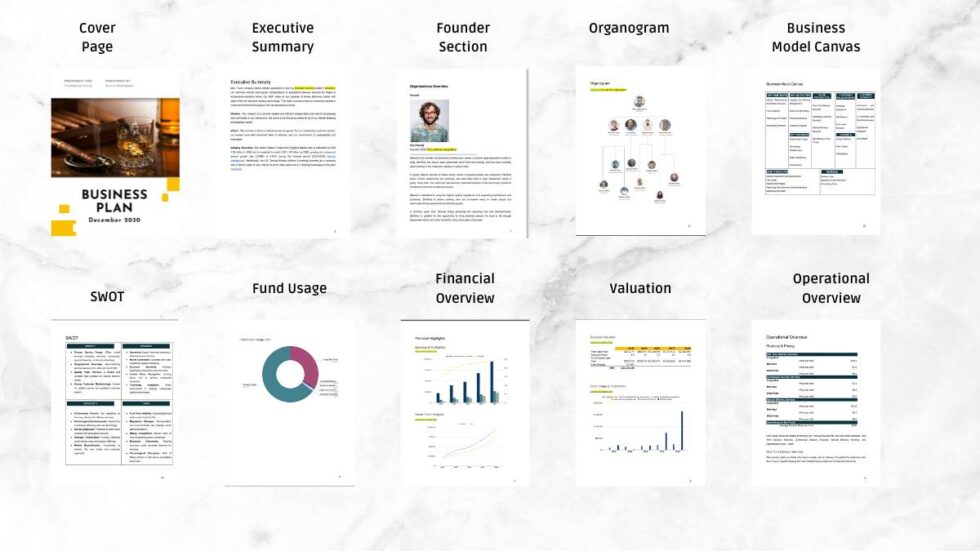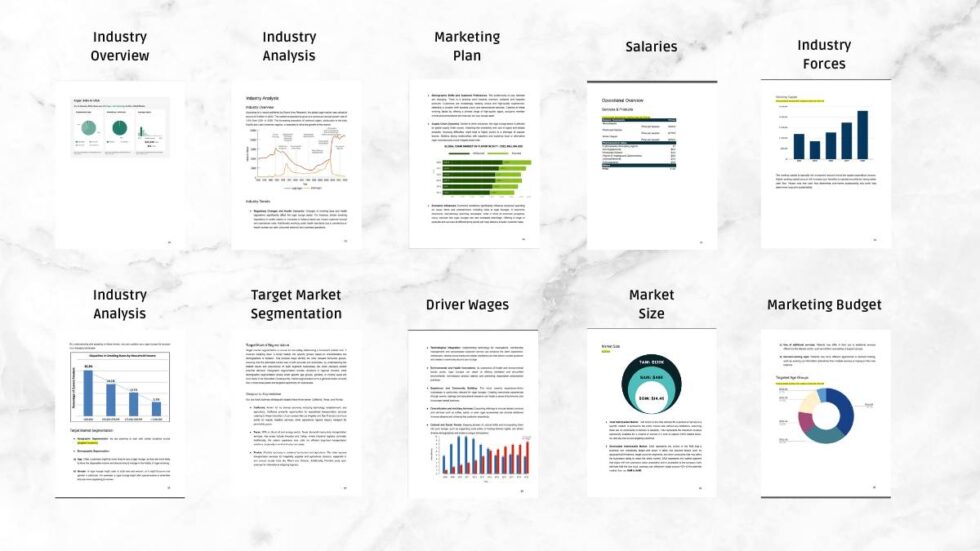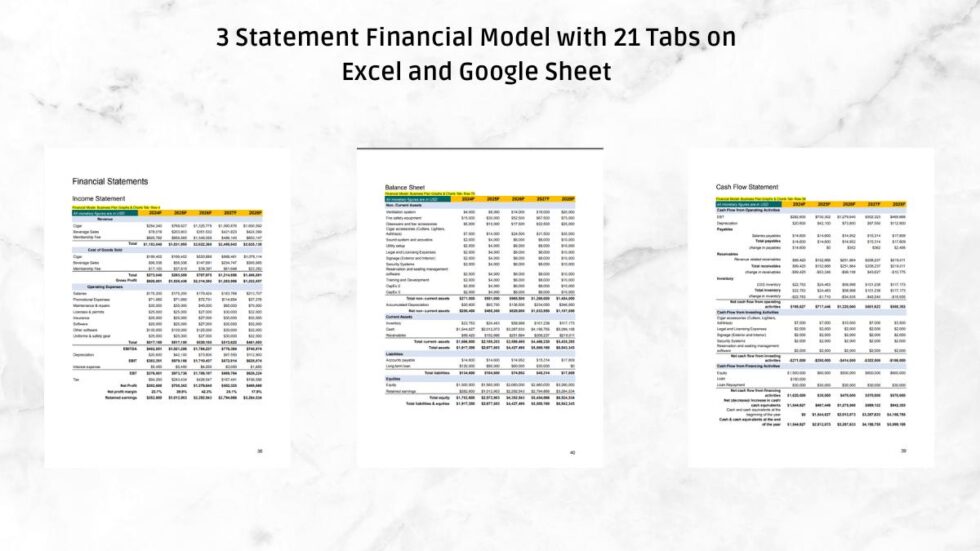Grab your doc file and spreadsheet fast before we run out of stock!

Dear Moving Company Owner,
Dive into the realm of creating a moving company that exemplifies top-notch service and reliability for customers in need of seamless relocations. Leave doubts behind as you step into the role of an innovative moving company entrepreneur. Our comprehensive guide serves as your roadmap from vision to reality. Begin your transformative journey now – where both your future clients and yourself will reap the benefits. ✨ #ElevateMovingExperience #DriveSuccess
Shift your mindset from ‘maybe someday’ to ‘let’s do this today’ with our Moving Company Business Plan and Financial Model Toolkit. Say goodbye to hesitation and embrace a clear, structured path to success. Turn your moving company vision into a thriving business, converting ideas into tangible accomplishments. Let’s conquer any uncertainties about taking that crucial first step!
Bid farewell to doubts and uncertainties. Our moving company business plan and toolkit provide a straightforward and actionable approach to launching your moving company. Dive into your entrepreneurial venture now, transitioning from concepts to delivering exceptional moving services to your clients.
Step away from generic templates with uninspiring projections and generic data!
If the thought of starting your moving company fills you with excitement and determination, fear not! Our meticulously crafted plan unveils every detail, guiding you seamlessly from concept to operational excellence, ensuring no crucial aspect is overlooked.
But Everyone Says This…Tell Me What’s Inside?
Here are just few of the questions answered in the business plan & financial model:
✔️Find out if it’s worth spending money and time into this idea.
✔️How much money can you make if you invest $X into this?
✔️Is $X amount of investment enough?
✔️When will the business break-even?
✔️Will you run out of cash if you invest $X amount?
Who is my target market?

How do I acquire customers from my target market?

Grab your doc file and spreadsheet fast before we run out of stock!

Discover Our Impact on Several Moving Company
Embark on an exciting journey to establish a moving company that embodies the essence of reliable and efficient relocations. Cast aside any doubts and uncertainties as you step into the role of a visionary moving company entrepreneur. Our all-encompassing guide paves a clear path from your moving company dream to the reality of a successful business. Start this transformative journey now – where both your future clients and yourself are poised to reap the rewards. ✨ #ElevateMovingExperience #DriveSuccess
Transition from mere aspirations to tangible achievements with our Moving Company Business Plan and Financial Model Toolkit. Leave behind any uncertainties and embrace a well-defined route to success. Watch your moving company vision come to life, turning your ideas into impactful outcomes. Confidently tackle and overcome any lingering fears as you take that crucial first step!
Say farewell to hesitations and uncertainties as you delve into our moving company business plan and toolkit, providing a streamlined and actionable approach to launching your moving business. Dive into the entrepreneurial world now, progressing from concept to the exciting launch of your moving services.
Move away from generic templates with uninspiring projections and tedious data!
If the thought of starting your moving company fills you with anticipation and drive, rest assured! Our expertly crafted plan guides you through every detail, leading you seamlessly from initial idea to operational excellence, ensuring all essential aspects are accounted for.
Cut The Bullshit And Show Me Some Goddamn Pages For Free So I Know What I’m Getting Here!
Okay, okay…Now, before we make this magical little exchange where you give me money and I give you your very own copy of the template……..
Sample Business Plan
We have written a business plan and financial model using this template so that you get a clear idea on how powerful the template is!

Sample Financial Model

But My Moving Company Is Different And This Won’t Work For Me…
That whisper of uncertainty may be lingering in your thoughts…
A cautious voice could be softly murmuring in your mind…
“This all appears promising”…
“But my moving company is truly unique, and these strategies may not align with my target audience”…
Rest assured, I GUARANTEE they will.
Imagine, if by some rare chance you implement the tactics outlined in this plan and they do not significantly elevate your moving company…
Does that seem reasonable? Fantastic.
Either I am daringly confident…
Or slightly off my rocker.
Honestly, find someone else who backs their toolkit like this. I mean it.
In any event.
Once you utilize the blueprint…
How to Write the Moving Company Business Plan?
I will write a complete business plan for Moving Company Plan in this demo!
Step 1: Download the Business Plan
After you download the Business Plan then you will be redirected to the Thank You Page which contains link to the business plan template and financial model. The click on the Business Plan Template Button and Financial Model to use them.
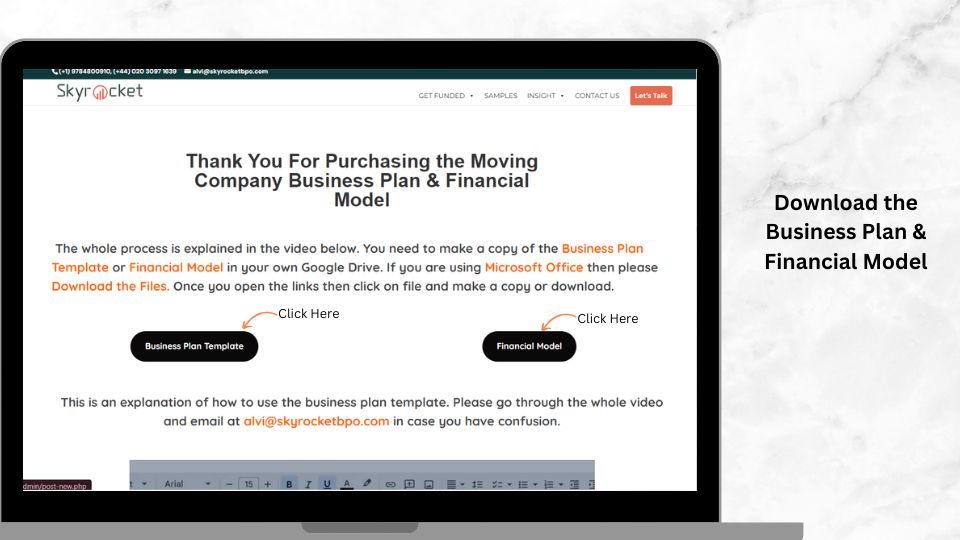
Step 2: Start with the Financial Model & Industry Analysis
You should start the Business Plan from the Financial Model and Industry Analysis sections as it helps you build the structure of the overall business and your plan.
When you open the financial model then it looks like this:
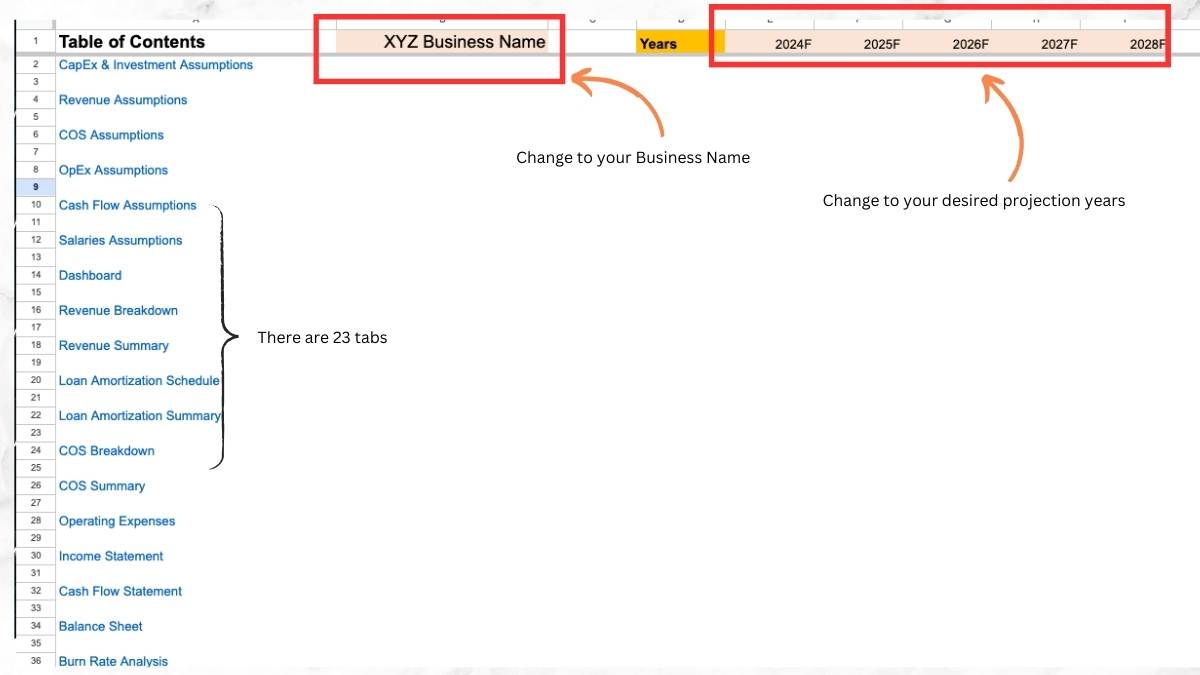
Step 2: Financial Model Starts with Investment
Uncover the ideal number of moving assignments required to achieve an annual revenue of $500K for your moving company. Whether you aim to invest your own funds or assess financing alternatives, input the relevant information in the specified sections of the financial model. If you are contemplating a loan with specific terms and interest rates, rest assured that the model will efficiently manage all necessary calculations.
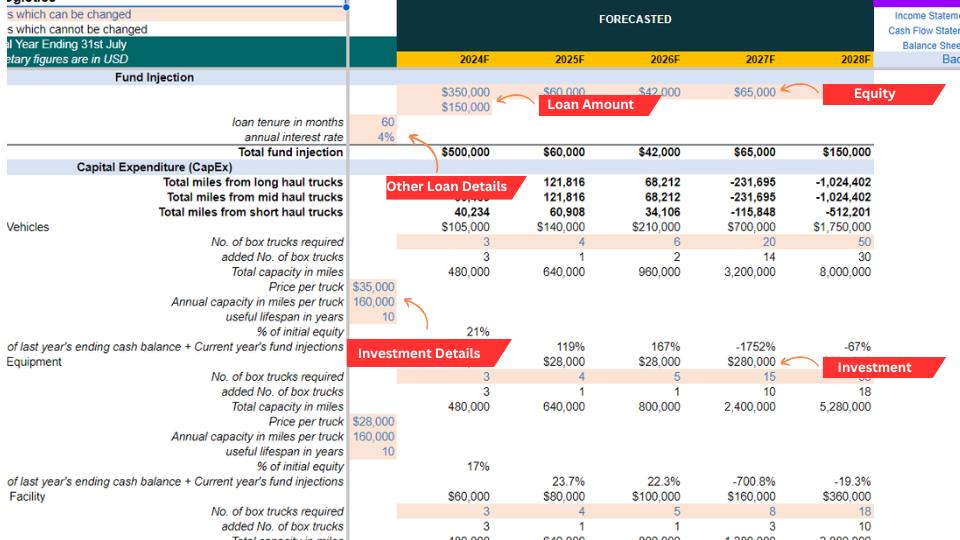
This section plays a vital role in our Moving Company Business Plan and Financial Model, where we have thoughtfully pre-set key components to simplify your planning process.
You have the flexibility to choose from a variety of options, such as different fleet sizes and vehicle types, with the opportunity to combine them for enhanced operational efficiency. Through extensive research, we have determined the costs associated with these fleet configurations, providing you with accurate projections without the need for extensive research on your end.
We have meticulously curated and included the prices for essential investment items like moving equipment, vehicles, and other crucial assets in the model. This eliminates the need for you to gather this information independently. However, if you wish to adjust any of the investment figures, you have the autonomy to make those modifications.

Step 3: Revenue Assumptions
The success of your moving company hinges on your ability to attract clients. When it comes to customer acquisition, you have two primary strategies: increasing marketing spend or engaging with potential clients organically. Our Moving Company Business Plan and Financial Model offers you the flexibility to tailor and align with these strategies.
Furthermore, our model encompasses various promotional channels that you can utilize, such as your company website, in-person marketing initiatives, Google Ads, and more. For example, if you are pursuing in-person marketing and have three team members dedicated to acquiring new clients through activities like personalized visits or cold calling, each with a monthly salary cost of $50K.
If, on average, they bring in 25 new customers monthly, the cost per customer acquisition is approximately $2,000.
Through our model, you can adjust these variables to assess the profitability of your business and determine if your cash flow can sustain ongoing operational success.


Let’s explore the revenue model for your moving company, aligning it with the client acquisition metrics discussed earlier. In the first year, envision your company attracting 100 new clients. Out of these, 70% may opt for regular services, indicating strong client loyalty or possibly a membership-oriented approach, while the remaining 30% may prefer one-time services or shorter engagements. This means that 70 clients contribute to your Recurring Client Revenue, and 30 clients to your One-Time Client Revenue.
Now, delving deeper into the group of recurring clients, consider:
– 40 clients who require frequent services, booking multiple moves per month (high frequency),
– 20 clients who prefer regular but less frequent services, adhering to specific schedules or seasonal demands (moderate frequency),
– 10 clients who may require services occasionally, such as for special events or short-term relocations (low frequency).
This segmentation enables a tailored revenue structure designed to fit the unique dynamics of your moving company, providing a detailed revenue forecast with monthly breakdowns. This strategic approach enhances the accuracy of revenue projections by addressing client acquisition rates, retention levels, and turnover dynamics – crucial components for financial planning and overall business strategy.
By utilizing monthly revenue forecasts, you can gain insightful metrics on client behaviors over time, including new client acquisition rates, the percentage of repeat clients, and client retention rates. This in-depth analysis supports precise financial planning and enables informed decision-making to drive the success of your moving company.

Step 4: Cost Assumptions
In the realm of your moving company business, distinguishing between variable and fixed costs is crucial for effective financial management. Variable costs are directly linked to the level of services rendered to clients. As your company handles more moves, expenses for services (such as labor, packing materials, and transportation) and operational costs will rise. Additional variable costs may include fuel, tolls, and vehicle maintenance, which fluctuate based on the volume of services provided, as well as expenses for facility maintenance and cleaning that increase with operational demands.
On the other hand, fixed costs remain consistent regardless of the number of moves completed. These encompass expenditures like office rent, employee salaries, insurance premiums, and software subscriptions. These costs remain steady regardless of fluctuations in the volume of moves.
Adhering to Generally Accepted Accounting Principles (GAAP) and guidelines from the Financial Accounting Standards Board (FASB), these costs are typically categorized as Cost of Services (COS) and Operating Expenses (OPEX):
Cost of Services (COS): This category includes all variable costs directly associated with providing moving services. It covers expenses for labor, supplies, vehicle maintenance, and other direct costs related to service delivery to clients.
Operating Expenses (OPEX): These represent your fixed costs, encompassing all overhead expenses in running the moving company that are not directly tied to service provision. This category includes rent, utilities, salaries for administrative staff, marketing costs, as well as software and general administrative expenses.
A clear comprehension of these cost differentials is vital for accurate financial reporting, forecasting future costs, and establishing competitive pricing strategies for your moving services, ensuring profitability and sustainable operations.



Step 5: Cash Flow Assumptions
Efficient cash flow management is vital for your moving company, requiring specific considerations regarding client payments, vendor transactions, and inventory control.
Client Payment Considerations: Delays in client payments or processing through booking platforms can impact your accounts receivable, potentially affecting cash flow. Offering incentives for prompt payments or enforcing stricter payment terms can help address this issue.
Vendor Payment Considerations: Temporarily extending payment terms to vendors for supplies like packing materials, equipment, and maintenance services can provide a short-term boost to cash flow. However, it is essential to manage these extensions wisely to maintain strong vendor relationships. Proactively negotiating extended payment timelines can enhance cash flow without jeopardizing vendor partnerships.
Inventory Considerations: Maintaining excessive inventory levels, particularly for supplies like packing materials and moving equipment, can tie up significant amounts of cash. Implementing strategies such as just-in-time (JIT) inventory management or improving inventory forecasting can help alleviate this financial strain. Finding the right balance between having sufficient inventory on hand and minimizing excess inventory costs is crucial for your moving company.
These considerations play a key role in financial planning and cash flow management strategy for your moving business. By effectively managing client payments, vendor transactions, and inventory control, you can cultivate a more stable cash flow, streamline operations, and create the financial flexibility to capitalize on growth opportunities within your moving company.
Now Let’s Dig Deeper….
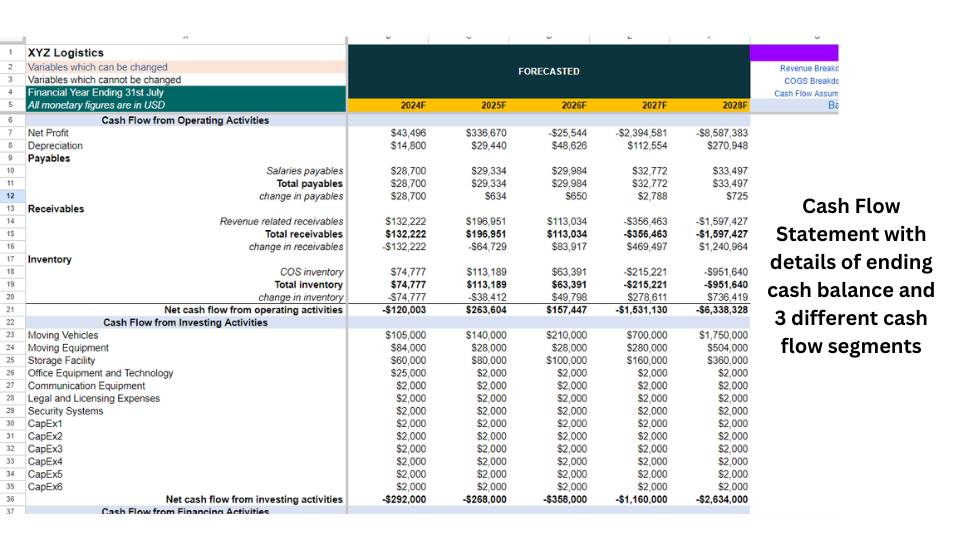
Step 5: Analyze Results of the Financial Model
Now that you have entered all assumptions into the model, what is the outcome?
Planning for Minimum Capital Requirements: Calculate the startup capital needed based on estimated expenses for initial infrastructure setup, marketing initiatives, moving equipment, and operating costs aligned with your service objectives.
Cash Flow Analysis: Assess the potential impact on cash flow under various scenarios, such as lower-than-expected client numbers initially, increased acquisition costs, or unforeseen rises in moving equipment expenses. This analysis helps evaluate the financial resilience of your moving company without significant initial investments.
Exploring Financing Options: Utilize this financial model to clarify the total capital requirements, rationale behind the amount, intended purpose of funds, expected timeline for achieving profitability, and comprehensive strategies for attaining financial objectives when considering financing through loans or investor support. It also supports your client service projections and growth plans with substantial data and assessments.
Viability Assessment: Evaluate the feasibility of launching and operating a moving company by scrutinizing market demands, competitive environment, pricing strategies, and cost structures.
Strategic Planning for Established Moving Companies: For existing moving companies, this financial model offers an objective assessment to refine strategies, enhance operations, and strategically plan for future expansion or introduction of new services.

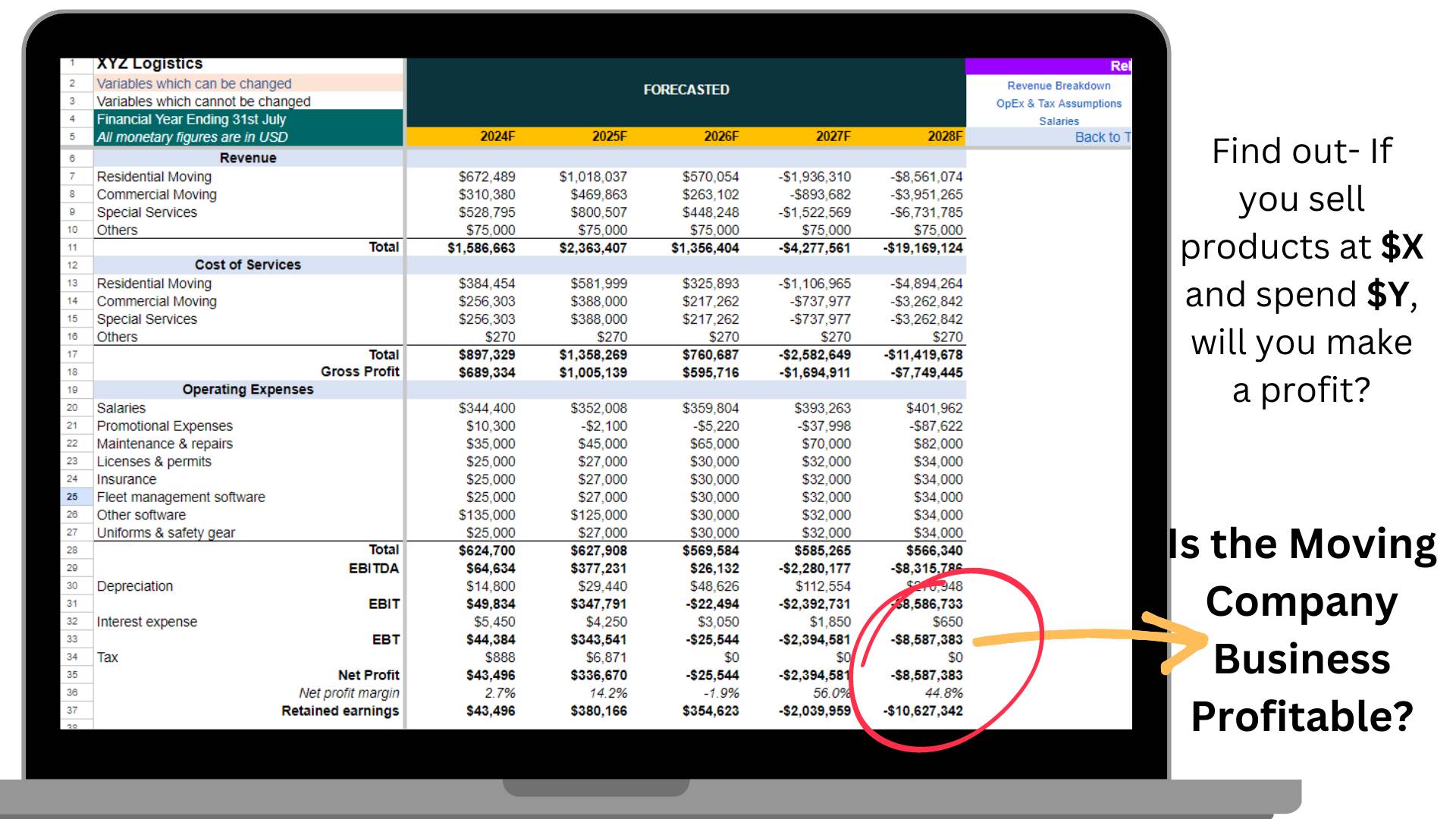
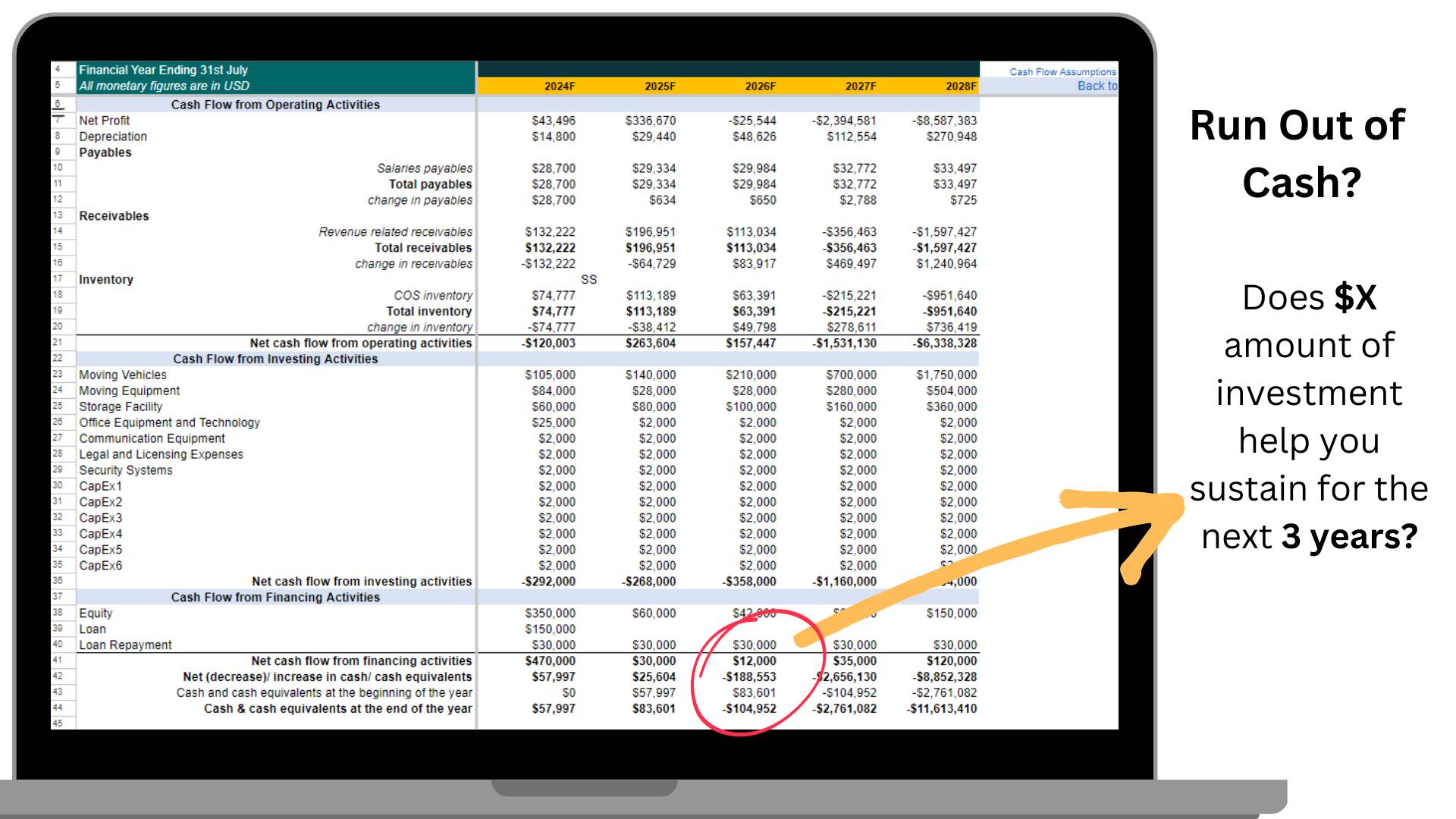
Step 6: Start Writing The Business Plan with Industry Analysis
Begin the business plan with an industry analysis to lay the foundation for refining details within the financial model. When conducting the competitive landscape analysis as part of the industry study for your moving company, it is crucial to gather pricing and relevant information about competitors. This process may include obtaining pricing details from competitors’ websites or social media profiles, and in some instances, engaging directly with competitors may be necessary. Understanding competitors’ pricing structures will aid in establishing the most suitable pricing strategy, which can then be incorporated into the financial model.
Step 6: Marketing Plan
Initiate your marketing strategy by defining the promotional channels you plan to utilize. Drawing from the competitive landscape analysis discussed in the previous industry analysis section for your moving company, you can pinpoint the promotional channels employed by your competitors. Utilizing tools like Semrush can provide insights into the performance of these promotional channels for a specific business, such as the monthly website visitor count for a competitor. This data can offer valuable insights into the competitor’s reach. Furthermore, analyzing the most frequented blog pages by the target audience on competitors’ websites can unveil engaging topics for your own target market.
Step 7: Operational Overview
Step 8: Organizational Overview
Compile a roster of employees you intend to hire, detailing their salaries and potential additional perks. Outline job descriptions for each role. Subsequently, design an organizational chart that visually represents the team hierarchy within the moving company structure.

Choose and adapt! The roles and job descriptions best suited for the moving company business plan have been provided. Retain the necessary elements and modify as necessary. The requirements of each moving company can vary. For example, if you are partnering with external logistics services, internal specialists may not be a priority.
Step 9: Executive Summary + Other Sections
Compile a list of staff members you intend to hire, along with their salaries and additional benefits. Define the job responsibilities for each role. Subsequently, develop an organizational chart that reflects the appropriate hierarchy within your moving company.
Reviews
340+ Downloads & Counting

The moving company business plan templates and financial model have been a game-changer for my startup. They’re incredibly detailed and easy to use, making my business planning a breeze.
★★★★★
I was hesitant at first, but the template and financial model have exceeded my expectations. They’ve provided me with a roadmap for success in the moving company business.
★★★★★
The moving company business plan is well-structured and comprehensive. Combined with the financial model, they’ve given me a clear understanding of the box truck market and its potential.
★★★★★
I’m impressed with the quality of the financial model. It had a lot of info which I did not even think of earlier.
★★★★★
F.A.Q
Yeah but will this template help me get a loan?
Maybe. This mostly depends on your business idea, previous experiences, ability to provide collateral and relevant factors. This is a template for present your plan in the best possible way. In addition, the financial model helps to validate your business concept or your expansion plan. It’s kind of hard to provide more for just $49.
Is the payment secure?
Our payment is processed by Stripe or PayPal so you can rest assured about your data privacy and security.
What is the refund or cancellation policy?
Due to the fact that templates are downloaded, we cannot give refunds.
Digital material is exempt from the 14-day return policy applicable to physical products. Because of this, our downloadable content are non-returnable. All sales are final. You can also check out the video in the product page to get an idea of contents of the template. This should help you get a clear idea on the features of the product.
However, we do value the customer experience and are accessible to assist you with any problems you may have while using our goods. If you have particular queries regarding our product, please use the chat box on this page or send an email to [email protected].
How can I edit the template?
Simple. If you are using Google Doc and Sheets then just make a copy in your own Google Drive. In case you are using Microsoft Office then Download the files and start editing.
What about support?
You can email us at [email protected] and we will respond in 24 to 48 Hrs. We offer in-person or email based support depending on your needs.
Every other reason for not buying....
❌ “But you can’t replace hiring a business plan writer to do this”
✅ This template costs $49 not $2,000. Also, you have more control over the writing process. The template is very specific so you will have relevant info in Industry Analysis, Financial Model and other sections.
❌ “I feel like just browsing online and using the free templates available online.
✅ Sure, if you wish to spend 4 weeks instead of 2 days to write a plan then please go ahead. Our research team found that free resources are very generic and does not offer fill-up and use facility. Also, you won’t get the specialized financial model from the free resources.
❌ But wouldn’t everyone’s content look the same?
✅ Nope. Our customers are smart and customize by adding their own images, logo, company description, etc.
❌ “But can you guaruntee that I will get a bank loan using this?
✅ No, I cannot guarantee anything for $49. The purpose of this template is to make it easier and less time consuming for you to write a business plan.
Who developed this template?
Our templates are developed by CPAs, CFAs and Ex- consultants of BCG, Mckinsey, PwC and KMPG. Elma Steven is the Head of our Quality Control.
Can I validate my the prospect of my MVP using this?
Yes. The financial model will help you plug in price, unit cost, payables and other assumptions which will allow you to project the revenue, profit and other KPIs.


